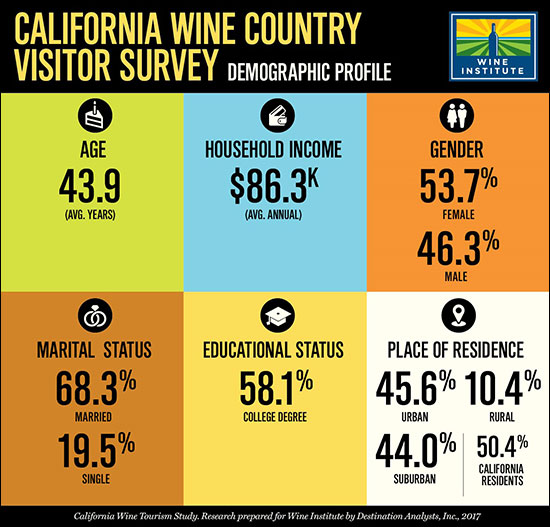Wine Institute Releases Results of New California Wine Tourism Survey
SAN FRANCISCO, Sept. 21, 2017
SAN FRANCISCO, Sept. 21, 2017 – Results of a new online survey of more than 2,000 U.S. adults who recently visited California wine country were released today, offering insights to wineries and local wine associations in understanding and enhancing the experience of visitors to wineries and regions. Commissioned by Wine Institute with support from a USDA grant and conducted by Destination Analysts of San Francisco, the comprehensive survey offers a profile of the typical California wine country visitor statewide and by region and examines their awareness, interests and behaviors. Fielded in late 2016, the survey gathered responses from an equal number of visitors from out of state and within the state in recognition of the importance of in-state visitors to wine regions. A California wine tourist was defined as someone who had visited a California wine region for leisure within the past three years to capture both high-involvement and casual wine tourists.
The California Wine Country Visitor:
Visitor Profile:
The profile of the California wine country visitor is consistent with wine drinker demographics. The average age of visitors to California wine country is 43.9 years old, with Baby Boomers accounting for 39.5 percent, Gen Xers 21.9 percent and Millennials 36.1 percent. The majority of visitors are married (68.3%), resides in an urban (45.6%) or suburban (44%) area and are slightly more likely to be female (53.7% vs. 46.3%). California wine region visitors are well-educated and have higher incomes compared to the national average leisure traveler.
Wine Is Important to Lifestyle:
More than 70 percent of California wine country visitors surveyed drink wine at least once a week with 36 percent drinking wine several times a week and nearly 20 percent imbibing daily. Nearly 60 percent consider wine “important” or “very important” to their lifestyles and see themselves as “very knowledgeable” about the beverage. About 30 percent have been a member of one or more wine clubs in the past three years, suggesting the potential for growth in wine club sign-ups but also serving as a reminder that while many wine tourists may not join clubs they do purchase wine from other outlets and recommend them to others based on winery visits.
High-End Travelers
Not surprisingly, California wine visitors highly value winery and restaurant experiences with three-quarters noting tastings, tours and food pairings at wineries to be “important” or “very important” and 70 percent identifying exceptional and interesting restaurants as a priority. Nearly 50 percent stayed in luxury hotels (48.3% four-star, 25.6% five-star) versus a national norm of about 15 percent staying in the equivalent of five-star properties. Visitors use a variety of resources in deciding which regions and wineries to visit and most often rely on word-of-mouth recommendations (62.3%) and general internet searches (43.9%). While most California wine region trips are driven by leisure vacations (32.6%) or weekend getaways (26.2%), nearly one in ten trips (8.5%) is an add-on to a business or convention trip.
Satisfied Visitors = Ambassadors
The vast majority of California wine visitors were highly satisfied with their trips and extremely likely to recommend the regions they visited to others. Over 70 percent of surveyed travelers preferred the California wine region they visited to out-of-state wine regions. About 73 percent found that the California wine region visited provided a “better” or “much better” experience. Residents from outside of the state gave the California wine experience higher ratings than those from California. Nearly 79 percent of travelers from other states gave a top score (8 or above on a 10-point scale), compared to 72 percent of Californians. Finally, visits to a wine region greatly increased the likelihood of purchasing wines from that region when travelers returned home, especially among out-of-state visitors (64% very likely to purchase).
Sources of Information
Word of mouth was by far the leading source of information (62%) for deciding what regions to visit, followed by general online search (44%), suggesting that social media and search optimization are very important communications channels for wineries and wine regions. Interestingly, wine magazines edged out travel magazines as an information source, while printed wine region maps came out higher than both (not everything has gone digital).
Regional Differences
The survey asked visitors to respond to a series of questions on regions they had visited in the past three years. Based on an analysis of responses, visitors to less well-known or remote wine regions of the state most closely mirror the high-involvement wine drinker versus visitors to more well-known regions. A higher percentage of visitors to lesser known regions regard wine as important to their lifestyles, are members of wine clubs and consider themselves knowledgeable about wine. This likely reflects both the dedication of high-involvement wine country visitors to seeking out new regions and a larger number of casual visitors to well-known regions – areas of opportunity for both wineries and regions.
About Wine Institute
Wine Institute is the public policy advocacy group of California wineries and affiliated businesses that represent the industry at the state, federal and international levels to enhance the ability to responsibly produce, promote and enjoy wine. California is the number one U.S. state for wine and food tourism with 24 million visits annually. The state’s 4,700 wineries produce 85 percent of U.S. wine and 97 percent of U.S. wine exports. Visit: www.wineinstitute.org for more information. The California Wine Tourism Survey was supported by the Specialty Crop Block Grant Program at the U.S. Department of Agriculture (USDA) through Grant 14-SCBGP-CA-006. Its contents are solely the responsibility of the authors and do not necessarily represent the official views of the USDA.




















